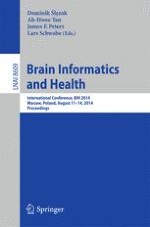This book constitutes the proceedings of the International Conference on Brain Informatics and Health, BIH 2014, held in Warsaw, Poland, in August 2014, as part of 2014 Web Intelligence Congress, WIC 2014. The 29 full papers presented together with 23 special session papers were carefully reviewed and selected from 101 submissions. The papers are organized in topical sections on brain understanding; cognitive modelling; brain data analytics; health data analytics; brain informatics and data management; semantic aspects of biomedical analytics; healthcare technologies and systems; analysis of complex medical data; understanding of information processing in brain; neuroimaging data processing strategies; advanced methods of interactive data mining for personalized medicine.
